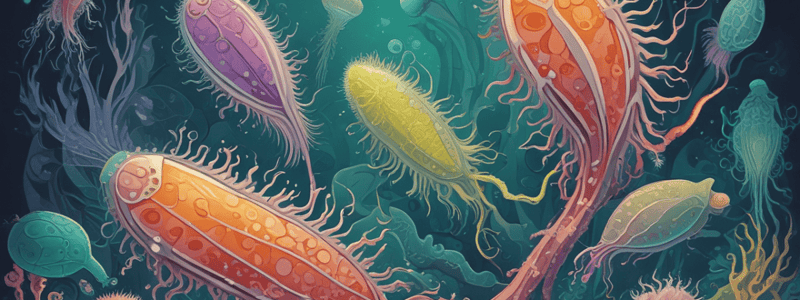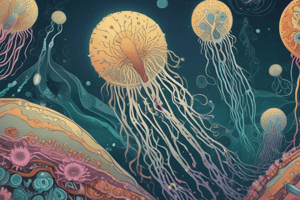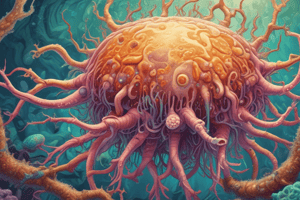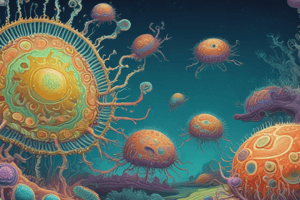Podcast
Questions and Answers
What is the primary characteristic that distinguishes Euglenozoa as a clade?
What is the primary characteristic that distinguishes Euglenozoa as a clade?
- The ability to be photosynthetic autotrophs
- The presence of membrane-bounded sacs under the plasma membrane
- The presence of a spiral or crystalline rod inside their flagella (correct)
- The presence of a single mitochondrion with a kinetoplast
What is the function of the alveoli in Alveolata?
What is the function of the alveoli in Alveolata?
- Unknown (correct)
- To provide structural support to the cell
- To increase photosynthetic efficiency
- To regulate cell growth
Which of the following is NOT a characteristic of Dinoflagellates?
Which of the following is NOT a characteristic of Dinoflagellates?
- Each cell is reinforced by cellulose plates
- They have two flagella
- They are found only in freshwater ecosystems (correct)
- They can be phototrophs, mixotrophs, or heterotrophs
What is the name of the disease caused by Trypanosoma gambiense?
What is the name of the disease caused by Trypanosoma gambiense?
Which supergroup is thought to have originated by a secondary endosymbiosis event with a red alga?
Which supergroup is thought to have originated by a secondary endosymbiosis event with a red alga?
What is the name of the toxic bloom caused by Dinoflagellates?
What is the name of the toxic bloom caused by Dinoflagellates?
Which group of organisms includes both free-living consumers of prokaryotes and parasites?
Which group of organisms includes both free-living consumers of prokaryotes and parasites?
What is the name of the single mitochondrion with an organized mass of DNA found in Kinetoplastids?
What is the name of the single mitochondrion with an organized mass of DNA found in Kinetoplastids?
What is a characteristic of protists that distinguishes them from other eukaryotes?
What is a characteristic of protists that distinguishes them from other eukaryotes?
Which of the following is NOT a nutritional strategy used by protists?
Which of the following is NOT a nutritional strategy used by protists?
What is a characteristic of single-celled protists?
What is a characteristic of single-celled protists?
Which group of protists includes Euglenozoa and Diplomonads?
Which group of protists includes Euglenozoa and Diplomonads?
What is a characteristic of the life cycle of some protists?
What is a characteristic of the life cycle of some protists?
Which group of protists includes Dinoflagellates and Apicomplexans?
Which group of protists includes Dinoflagellates and Apicomplexans?
What is a characteristic of the supergroup SAR?
What is a characteristic of the supergroup SAR?
What is a characteristic of the supergroup Excavates?
What is a characteristic of the supergroup Excavates?
What is the primary function of pseudopodia in radiolarians?
What is the primary function of pseudopodia in radiolarians?
What is the characteristic feature of foraminiferan tests?
What is the characteristic feature of foraminiferan tests?
What is the supergroup that includes red algae, green algae, and land plants?
What is the supergroup that includes red algae, green algae, and land plants?
What is the primary pigment responsible for the reddish color of red algae?
What is the primary pigment responsible for the reddish color of red algae?
What is the term for the process by which radiolarians capture food using their pseudopodia?
What is the term for the process by which radiolarians capture food using their pseudopodia?
What is the term for the group of organisms that includes animals, fungi, and some protists?
What is the term for the group of organisms that includes animals, fungi, and some protists?
What is the term for the algae that are most closely related to land plants?
What is the term for the algae that are most closely related to land plants?
What is the term for the process by which foraminiferan tests are preserved in marine sediments?
What is the term for the process by which foraminiferan tests are preserved in marine sediments?
Flashcards are hidden until you start studying
Study Notes
Euglenozoa
- A diverse clade that includes euglenids and kinetoplastids
- Members can be predatory heterotrophs, photosynthetic autotrophs, or parasites
- Characterized by a spiral or crystalline rod of unknown function inside their flagella
- Euglenids have one or two flagella that emerge from a pocket at one end of the cell
- Kinetoplastids have a single mitochondrion with an organized mass of DNA called a kinetoplast
Kinetoplastids
- Include free-living consumers of prokaryotes in freshwater, marine, and moist terrestrial ecosystems
- Examples: Trypanosoma gambiense (causes sleeping sickness in humans) and another pathogenic trypanosome that causes Chagas’ disease leading to congestive heart failure
SAR (Supergroup)
- Proposed to have originated by a secondary endosymbiosis event involving a red alga
- A controversial clade that includes alveolates and stramenopiles
Alveolata (Sub-group)
- Characterized by membrane-bounded sacs (alveoli) just under the plasma membrane
- Function of alveoli is unknown
- Includes dinoflagellates, apicomplexans, and ciliates
Dinoflagellates
- Have two flagella and each cell is reinforced by cellulose plates
- Abundant components of both marine and freshwater phytoplankton
- A diverse group of aquatic phototrophs, mixotrophs, and heterotrophs
- Can cause toxic "red tides" through blooms
Protists
- The informal name for a group of mostly unicellular eukaryotes that are not fungi, plants, or animals
- A polyphyletic group, with Protista no longer valid as a kingdom
- Can be unicellular, colonial, or multicellular
- Nutritionally diverse, including photoautotrophs, heterotrophs, and mixotrophs
- Can reproduce asexually, sexually, or by alternation of generations
Archaeplastida (Supergroup)
- Includes red algae, green algae, and land plants
- Characterized by the presence of chloroplasts
Rhodophyta (Red Algae)
- Reddish in color due to the accessory pigment phycoerythrin
- Multicellular; the largest are seaweeds
- Most abundant large algae in coastal waters of the tropics
Green Algae
- Named for their grass-green chloroplasts
- Plants are descended from green algae
- A paraphyletic group, with two main groups: chlorophytes and charophytes
- Chlorophytes live in freshwater, although many are marine
- Charophytes are the most closely related to land plants
Unikonta (Supergroup)
- Includes animals, fungi, and some protists
- Characterized by the presence of amoebozoans and opisthokonts (animals, fungi, and related protists)
- The root of the eukaryotic tree remains controversial
Studying That Suits You
Use AI to generate personalized quizzes and flashcards to suit your learning preferences.




